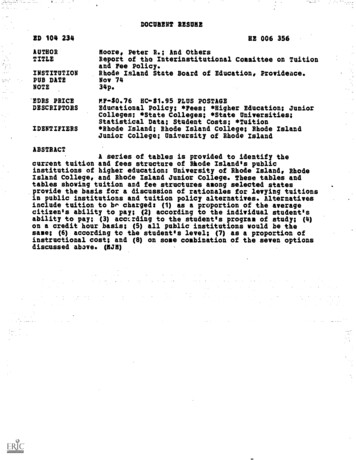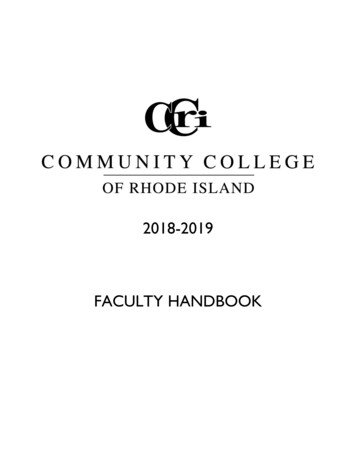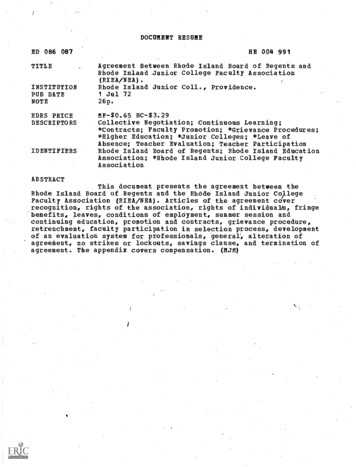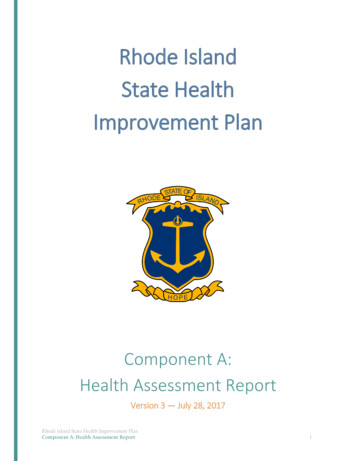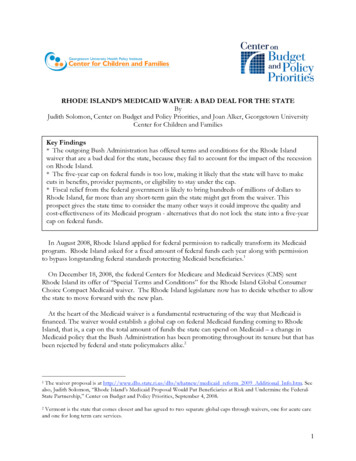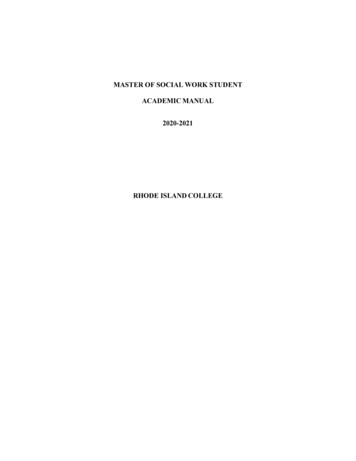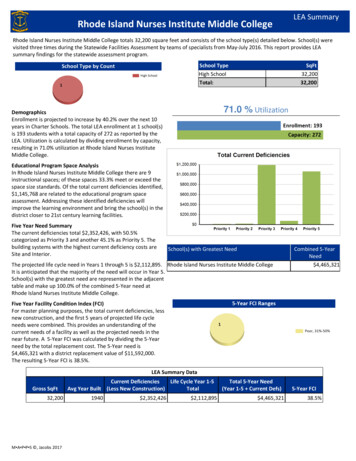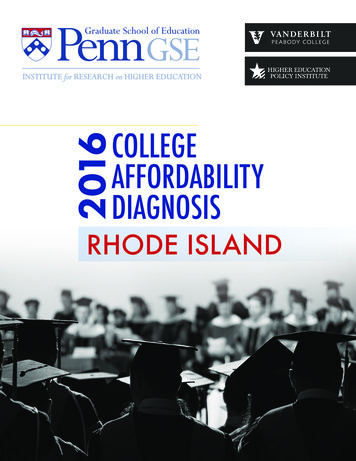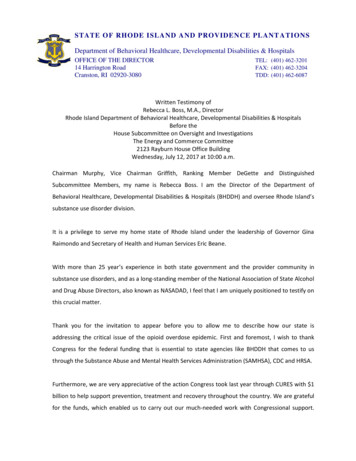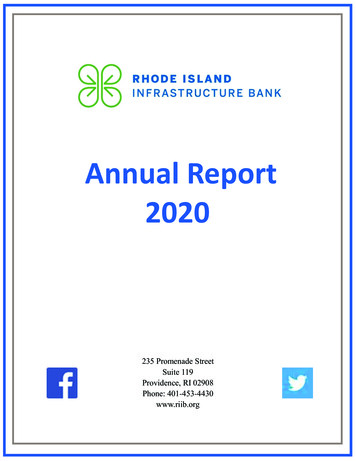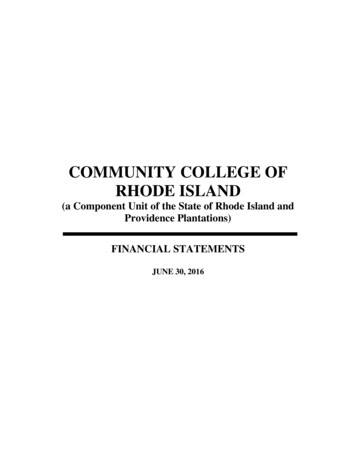
Transcription
COMMUNITY COLLEGE OFRHODE ISLAND(a Component Unit of the State of Rhode Island andProvidence Plantations)FINANCIAL STATEMENTSJUNE 30, 2016
COMMUNITY COLLEGE OF RHODE ISLAND(a Component Unit of the State of Rhode Island and Providence Plantations)Financial StatementsJune 30, 2016CONTENTSIndependent Auditors’ Report1-2Management’s Discussion and Analysis (Unaudited)3-17Financial Statements:Statement of Net Position18Statement of Revenues, Expenses and Changes in Net Position19Statement of Cash Flows20Notes to the Financial Statements21-47Required Supplementary Information:Schedule of Proportionate Share of the Net Pension Liability (Unaudited)48Schedule of Contributions (Unaudited)49Notes to the Required Supplementary Information (Unaudited)50Independent Auditors' Report on Internal Control Over FinancialReporting and on Compliance and Other Matters Based on anAudit of Financial Statements Performed in Accordance withGovernment Auditing Standards51-52
INDEPENDENT AUDITORS' REPORT ON SCHEDULESThe Board of EducationState of Rhode Island and Providence PlantationsProvidence, Rhode IslandReport on the Financial StatementsWe have audited the accompanying financial statements of the Community College of RhodeIsland (a component unit of the State of Rhode Island and Providence Plantations) (the"Community College") which comprise the statement of net position as of June 30, 2016, and therelated statements of revenues and expenses, changes in net position and cash flows for the yearthen ended, and the related notes to the financial statements, which collectively comprise theCommunity College's basic financial statements as listed in the table of contents.Management's Responsibility for the Financial StatementsManagement is responsible for the preparation and fair presentation of these financial statementsin accordance with accounting principles generally accepted in the United States of America; thisincludes the design, implementation, and maintenance of internal control relevant to thepreparation and fair presentation of financial statements that are free from material misstatement,whether due to fraud or error.Auditors' ResponsibilityOur responsibility is to express an opinion on these financial statements based on our audit. Wedid not audit the financial statements of Community College of Rhode Island Foundation, Inc.(the "Foundation") as of June 30, 2016 as discussed in Note 1. Those statements were audited byother auditors whose report has been furnished to us, and our opinion, insofar as it relates to theamounts included for the Foundation, is based solely on the report of the other auditors. Weconducted our audit in accordance with auditing standards generally accepted in the UnitedStates of America and the standards applicable to financial audits contained in GovernmentAuditing Standards, issued by the Comptroller General of the United States. Those standardsrequire that we plan and perform the audit to obtain reasonable assurance about whether thefinancial statements are free from material misstatement.An audit involves performing procedures to obtain audit evidence about the amounts anddisclosures in the financial statements. The procedures selected depend on the auditors'judgment, including the assessment of the risks of material misstatement of the financialstatements, whether due to fraud or error. In making those risk assessments, the auditorconsiders internal control relevant to the entity's preparation and fair presentation of the financialstatements in order to design audit procedures that are appropriate in the circumstances, but notfor the purpose of expressing an opinion on the effectiveness of the entity's internal control.Accordingly, we express no such opinion. An audit also includes evaluating the appropriatenessof accounting policies used and the reasonableness of significant accounting estimates made bymanagement, as well as evaluating the overall presentation of the financial statements.We believe that the audit evidence we have obtained is sufficient and appropriate to provide abasis for our audit opinion.25 Braintree Hill Office Park Suite 102 Braintree, MA 02184 P:617.471.1120 F:617.472.756027 Church Street Winchester, MA 01890 P:781.729.4949 F:781.729.5247www.ocd.com
OpinionIn our opinion, based on our audit and the report of other auditors, the financial statementsreferred to above present fairly, in all material respects, the net position of the CommunityCollege of Rhode Island as of June 30, 2016, and the changes in net position, and its cash flowsfor the year then ended in accordance with accounting principles generally accepted in theUnited States of America.Required Supplementary InformationAccounting principles generally accepted in the United States of America require thatmanagement's discussion and analysis on pages 3-17, the schedule of proportionate share of thenet pension liability on page 48, the schedule of contributions on page 49, and the notes to therequired supplementary information on page 50 be presented to supplement the basic financialstatements. Such information, although not a part of the basic financial statements, is requiredby the Governmental Accounting Standards Board, who considers it to be an essential part offinancial reporting for placing the basic financial statements in an appropriate operational,economic, or historical context. We have applied certain limited procedures to the requiredsupplementary information in accordance with auditing standards generally accepted in theUnited States of America, which consisted of inquiries of management about the methods ofpreparing the information and comparing the information for consistency with management'sresponses to our inquiries, the basic financial statements, and other knowledge we obtainedduring our audit of the basic financial statements. We do not express an opinion or provide anyassurance on the information because the limited procedures do not provide us with sufficientevidence to express an opinion or provide any assurance.Other Reporting Required by Government Auditing StandardsIn accordance with Government Auditing Standards, we have also issued our report datedOctober 6, 2016 on our consideration of the Community College of Rhode Island's internalcontrol over financial reporting and on our tests of its compliance with certain provisions oflaws, regulations, contracts, and grant agreements and other matters. The purpose of that reportis to describe the scope of our testing of internal control over financial reporting and complianceand the results of that testing, and not to provide an opinion on internal control over financialreporting or on compliance. That report is an integral part of an audit performed in accordancewith Government Auditing Standards in considering the Community College of Rhode Island'sinternal control over financial reporting and compliance.Certified Public AccountantsBraintree, MassachusettsOctober 6, 2016
COMMUNITY COLLEGE OF RHODE ISLAND(a Component Unit of the State of Rhode Island and Providence Plantations)Management’s Discussion and Analysis (Unaudited)June 30, 2016IntroductionThe following management discussion and analysis (MD&A) provides management’s view ofthe financial position of the Community College of Rhode Island (the “Community College”) asof June 30, 2016 and the results of operations for the year then ended, with selected comparativeinformation for the year ended June 30, 2015. The purpose of the MD&A is to assist readers inunderstanding the accompanying financial statements by providing an objective andunderstandable analysis of the Community College’s financial activities based on currentlyknown facts, decisions, and conditions. This analysis has been prepared by management, whichis responsible for the completeness and fairness of the information contained therein. TheMD&A consists of highly summarized information, and should be read in conjunction with theCommunity College’s financial statements and notes thereto, which follow this section.The Community College is New England’s largest public, two-year college with an averageenrollment of 15,611 full and part-time for-credit students in the 2016 academic year. Themission of the Community College is to provide all Rhode Island residents with open access topostsecondary education. It is also open to out-of-state students.The Community College offers a variety of academic programs that award associate’s degrees orprepare students for transfer to four-year colleges or universities. In addition, technical careerprograms are offered primarily to equip students with the skills needed to obtain employment inRhode Island businesses, industries, and service agencies. It also develops educational andtraining programs for local businesses and industries to further the state’s economic developmentobjectives.The Community College offers extensive community programming as well. It opens its facilitiesfor public use, sponsors programs on issues of public concern, and offers workshops andseminars for businesses, for government agencies and for individuals seeking to improve theirskills or enhance their lives.Community College courses are offered in a variety of locations across the state. The KnightCampus in Warwick, the Flanagan Campus in Lincoln, the Liston Campus in Providence, andthe Newport Campus are the main campuses of the Community College. Classes are also offeredat satellite facilities in Providence and Westerly.-3-
COMMUNITY COLLEGE OF RHODE ISLAND(a Component Unit of the State of Rhode Island and Providence Plantations)Management’s Discussion and Analysis (Unaudited) - ContinuedJune 30, 2016Introduction - ContinuedThe Rhode Island Junior College system was established by an act of the Rhode Island GeneralAssembly in 1960. In 1980, the Rhode Island Board of Regents for Education approved a changein the name of the Community College from Rhode Island Junior College to the CommunityCollege of Rhode Island to reflect the true mission of the institution. The Board of Governors forHigher Education (the “Board of Governors”) became the governing body for the CommunityCollege in 1981.In June 2012, the Rhode Island General Assembly approved a reorganization of the entire RhodeIsland system of public education. The Rhode Island General Assembly established the RhodeIsland Board of Education (the "BOE") effective January 1, 2013, to oversee the elementary,secondary, and postsecondary education for the state. In June 2014, the Rhode Island GeneralAssembly approved the reorganization of the entire Rhode Island system of public education.The legislation enlarged the BOE to seventeen (17) members in order for the Board to populatetwo Councils: Council for Elementary and Secondary Education and the Council for PostSecondary Education (the “Councils”). Each of the two Councils will be responsible for thesignificant portion of the governance and regulation per RIGL 16-60-1 and 16-60-4 forElementary/Secondary and per RIGL 16-59-1 and 16-59-4 for Post-Secondary.The mission of the BOE is to provide long-range planning and coordination and evaluation ofpolicies and programs for the public education systems of the state and specifically: To develop and adopt educational, financial and operational goals for the educationsystems of the state that represent achievable benchmarks for a 10-year and 20-year timeto be implemented by the two Councils and the commissioners.To ensure that the education systems of the state are aligned with the projectedopportunities in workforce development and economic development and that theeducation systems are preparing students to participate in the future workforce of RhodeIsland.To coordinate programs and courses of study and promote collaboration between andamong pre-kindergarten through higher education institutions and agencies.To present strategic budget and finance recommendations to the council on elementaryand secondary education and council on postsecondary education that are aligned withthe long-range goals adopted by the board.-4-
COMMUNITY COLLEGE OF RHODE ISLAND(a Component Unit of the State of Rhode Island and Providence Plantations)Management’s Discussion and Analysis (Unaudited) - ContinuedJune 30, 2016Financial HighlightsThe Community College’s financial position remained strong as of June 30, 2016. Net positionincreased by 2.1 million over the prior year.At June 30, 2016, the Community College’s assets of 108.1 million and deferred outflows of 2.3 million exceeded its liabilities of 47.6 million and deferred inflows of 0.7 million by 62.1 million, an increase over the prior year of 2.1 million. At June 30, 2015, the CommunityCollege’s assets of 104.4 million and deferred outflows of 2.3 million exceeded its liabilitiesof 44.4 million and deferred inflows of 2.3 million by 60.0 million, an increase over the prioryear of 3.8 million. The resulting net position is summarized into the following categories forthe fiscal years ended June 30:Net Position(in millions )20162015Net investment in capital assetsRestricted - expendableUnrestricted 76.6 0.0(14.5)73.51.9(15.4)Total net position 62.1 60.0The restricted expendable may be expended only for the purposes authorized by the donor orgrantor.Fiscal year 2016 operating revenues before net investment return decreased by 3% or 2.3million. Operating expenses increased by 0.4% or 0.4 million.-5-
COMMUNITY COLLEGE OF RHODE ISLAND(a Component Unit of the State of Rhode Island and Providence Plantations)Management’s Discussion and Analysis (Unaudited) - ContinuedJune 30, 2016Financial Highlights - ContinuedThe following chart provides a graphical breakdown of total revenues by category for the fiscalyear ending June 30, 2016:CCRI RevenuesFiscal Year Ended June 30, 2016Capital & sh flow continued to be adequate for operations with an operating cash balance of 20.2 million at June 30, 2016, an increase of 1.9 million from June 30, 2015. Prior year cashflow was also adequate for operations with an operating cash balance of 18.3 million at June 30,2015.Overview of the Financial StatementsThe financial statements focus on the Community College as a whole, rather than uponindividual funds or activities and have two primary components: 1) the financial statements and2) the notes to the financial statements.The Community College of Rhode Island Foundation (the “Foundation”) is a legally separate taxexempt component unit of the Community College of Rhode Island. The Foundation actsprimarily as a fundraising organization to supplement the resources that are available to theCommunity College in support of its programs. The Board of the Foundation is selfperpetuating and primarily consists of graduates and friends of the Community College.-6-
COMMUNITY COLLEGE OF RHODE ISLAND(a Component Unit of the State of Rhode Island and Providence Plantations)Management’s Discussion and Analysis (Unaudited) - ContinuedJune 30, 2016Overview of the Financial Statements - ContinuedAlthough the Community College does not control the timing or the amount of receipts from theFoundation, the majority of resources received or held by the Foundation are restricted to theactivities of the Community College by the donors. Because these resources held by theFoundation can only be used by or are for the benefit of the Community College, the Foundationis considered a component unit of the Community College and is discretely presented in theCommunity College’s financial statements. Management’s Discussion and Analysis is requiredto focus on the Community College, not its component unit.The Financial StatementsThe financial statements are designed to provide readers with a broad overview of theCommunity College’s finances and are comprised of three basic statements. These statementspresent financial information in a form similar to that used by private institutions of highereducation and corporations.The Statement of Net Position presents information on all of the Community College’s assets,deferred outflows, liabilities and deferred inflows, with the difference being reported as netposition. Over time, increases or decreases in net position may serve as a useful indicator ofwhether the financial position of the Community College is improving or deteriorating. Otherfactors are also relevant to assessing the Community College’s overall financial health. Theseinclude the trend, quality, and retention and size of student enrollments; diversification ofrevenue streams; management of costs; and condition of facilities.The Statement of Revenues, Expenses and Changes in Net Position shows how the CommunityCollege’s net position changed during the most recent fiscal year. This statement reports totaloperating revenues and expenses, non-operating revenues and expenses, and capital additionsand deletions. All changes in net position are reported as soon as the underlying event giving riseto the change occurs, regardless of the timing of related cash flows. Thus, revenues and expensesare reported in this statement for some items that will result in cash flows only in future fiscalperiods (e.g. the payment for accrued compensated absences, or the receipt of amounts due fromstudents and others for services rendered).-7-
COMMUNITY COLLEGE OF RHODE ISLAND(a Component Unit of the State of Rhode Island and Providence Plantations)Management’s Discussion and Analysis (Unaudited) - ContinuedJune 30, 2016The Financial Statements - ContinuedThe Statement of Cash Flows is reported on the direct method. The direct method of cash flowreporting portrays net cash flows from operations as major classes of operating receipts (e.g.tuition and fees) and disbursements (e.g. cash paid to employees for services).The financial statements can be found on pages 18 to 20 of this report.The Community College reports its operations as a business type activity using the economicresource measurement focus and full accrual basis of accounting. As a component unit of theState of Rhode Island and Providence Plantations, the results of the Community College’soperations, its net position and cash flows are also summarized in the State’s ComprehensiveAnnual Financial Report.Notes to the Financial StatementsThe notes provide additional information that is essential to a full understanding of the dataprovided in the financial statements. They also provide information regarding both theaccounting policies and procedures the Community College has adopted, as well as additionaldetail of certain amounts contained in the financial statements. The notes to the financialstatements can be found on pages 21 to 47 of this report.Financial AnalysisAs noted earlier, net position may serve over time as a useful indicator of the CommunityCollege’s financial position. In the case of the Community College, assets and deferred outflowsexceeded liabilities and deferred inflows by 62.1 million at the close of fiscal year 2016, anincrease of 2.1 million over fiscal 2015. Assets and deferred outflows exceeded liabilities anddeferred inflows by 60.0 million at the close of fiscal year 2015. Details are shown in the chartbelow in millions:-8-
COMMUNITY COLLEGE OF RHODE ISLAND(a Component Unit of the State of Rhode Island and Providence Plantations)Management’s Discussion and Analysis (Unaudited) - ContinuedJune 30, 2016Financial Analysis - ContinuedCondensed Statement of Net Position( in millions)2016Assets:Current assetsNoncurrent assets Total assetsDeferred outflows of Resources:Deferred outflowsTotal Deferred outflowsLiabilities:Current liabilitiesNoncurrent liabilitiesTotal liabilitiesDeferred Inflows of Resources:Deferred InflowsTotal Deferred InflowsNet Position:Net investment in capital assetsRestricted, expendableUnrestricted201525.5 l net position 62.1 60.0The largest portion of the Community College’s net position, 76.6 million, reflects itsinvestment in capital assets (such as land, buildings, machinery, and equipment), less any relatedoutstanding debt used to acquire those assets. The Community College uses these capital assetsto provide services to students, faculty and administration. Consequently, these assets are notavailable for future spending.-9-
COMMUNITY COLLEGE OF RHODE ISLAND(a Component Unit of the State of Rhode Island and Providence Plantations)Management’s Discussion and Analysis (Unaudited) - ContinuedJune 30, 2016Financial Analysis - ContinuedAlthough the Community College’s investment in its capital assets is reported net of related debt,it should be noted that the resources needed to repay this debt must be provided from othersources, since the capital assets themselves cannot be used to liquidate these liabilities. Also, inaddition to the debt noted above, which is reflected in the Community College’s financialstatements, the State of Rhode Island regularly provides financing for certain capital projectsthrough the issuance of general obligation bonds and appropriations from the Rhode IslandCapital Fund. Borrowings by the State from these funds are not reflected in these financialstatements. Additional financing for certain capital projects is provided by the issuance ofrevenue bonds by the Rhode Island Health and Educational Building Corporation, a quasi-publicstate agency. The Community College does not have a separate bond rating. All revenue bondsmust be approved by and arranged through the Rhode Island Board of Education. Revenue bondrelated indebtedness is reported on the Community College’s financial statements. BOE bondsissued for the Community College are rated between Aa3 and A1 by Moody’s. Net pensionliability of 29.1 million, bonds of 5.9 million and compensated absences of 4.4 million arethe Community College’s largest liabilities.- 10 -
COMMUNITY COLLEGE OF RHODE ISLAND(a Component Unit of the State of Rhode Island and Providence Plantations)Management’s Discussion and Analysis (Unaudited) - ContinuedJune 30, 2016Financial Analysis - ContinuedCondensed Statement of Revenues and ExpensesYears Ended June 30, 2016 and 2015( in millions)2016Operating revenues:Tuition and fees, netScholarships, grants, and contractsAuxiliary enterprisesOther 201524.7 21.45.56.0Total operating expenses120.9120.5Net operating loss(49.1)(46.4)47.70.1(0.2)45.50.1(0.2)Net nonoperating revenues47.645.4Decrease in net positionbefore capital contributions(1.5)(1.0)3.64.82.1 3.8Total operating revenuesOperating expenses:Salaries and benefitsSupplies and servicesScholarships, grants, and contractsDepreciation and amortizationNonoperating revenues (expenses):State and other appropriationsNet investment incomeOther nonoperating expenses, netCapital gifts and appropriationsIncrease in net position - 11 -
COMMUNITY COLLEGE OF RHODE ISLAND(a Component Unit of the State of Rhode Island and Providence Plantations)Management’s Discussion and Analysis (Unaudited) - ContinuedJune 30, 2016Financial Analysis - ContinuedOperating RevenuesTotal operating revenues for fiscal year 2016 were 71.8 million, a decrease of 2.3 million fromthe prior fiscal year. Total operating revenues for fiscal year 2015 were 74.1 million. The mostsignificant sources of operating revenue for the Community College are tuition and fees, grantsand contracts, and auxiliary services. Significant changes in operating revenue resulted from: The BOE froze tuition for the Fall and Spring semesters of FY 2016. Average enrollmentfor fiscal year 2016 decreased by 1,106.Federal, state, and private grant and contract activity increased 1.1 million in fiscal year2016 and decreased by 1.4 million in fiscal year 2015. The increase in 2016 is due to anincrease in grant activity.Operating ExpensesOperating expenses in fiscal year 2016 totaled 120.9 million, an increase of 0.4 million fromfiscal year 2015. Of this total, 72.0 million or 60% was used for instruction, academic andstudent support in 2016 ( 70.1 million or 58% in 2015). Depreciation expense totaled 7 millionin fiscal year 2016 and 6 million in fiscal year 2015.Non-Operating RevenuesTotal non-operating revenues for fiscal year 2016 were 47.6 million, including the stateappropriation of 47.7 million. Total non-operating revenues for fiscal year 2015 were 45.4million, including the state appropriation of 45.5 million. This was an increase in total nonoperating revenues of 2.2 million from the prior year. Due to the nature of public highereducation, institutions incur a loss from operations. State appropriations to the CommunityCollege, reported as non-operating revenue, are the primary resource for offsetting the loss fromoperations.OtherCapital gifts and capital appropriations of 3.6 million in fiscal year 2016 ( 4.8 million infiscal year 2015) represent general obligation funds spent by the state of Rhode Island toconstruct or acquire capital assets utilized by the Community College as well as otherappropriations and capital gifts from the Foundation.- 12 -
COMMUNITY COLLEGE OF RHODE ISLAND(a Component Unit of the State of Rhode Island and Providence Plantations)Management’s Discussion and Analysis (Unaudited) - ContinuedJune 30, 2016Capital Asset and Debt AdministrationCapital PlanThe Rhode Island Board of Education submits a running five fiscal year capital improvementplan known as the C.I.P., to the General Assembly and State Executive Branch each year inconjunction with the State’s capital planning process. This plan includes proposed capital assetprotection projects for the Community College. The recently submitted FY 2018-2022 capitalrequest for the Community College totaling 55.7 million includes long-term projects in progressthat are funded and capital project requests which are being submitted for planning, support andfunding. This plan forms the basis for discussions on funding the various projects from allavailable funding sources. During fiscal year 2016, the Community College expended a net 9.5million on plant related projects ( 10.5 million in fiscal year 2015). The Community Collegegenerally has funded its capital plans through a combination of funds received from CommunityCollege operations, State of Rhode Island Capital appropriations (RICAP), general obligationbonds, bonds issued through Certificates of Participation (COPS), or funding through the RhodeIsland Health and Education Building Corporation (RIHEBC). The execution of the CommunityCollege’s capital improvement plan is contingent upon approval by and sufficient funding fromthe State. The 2016-2017 state budget passed by the Rhode Island General Assembly supportsconsideration for funding a total of 35.7 million in capital projects for the fiscal year period ofFY17 through FY21.Capital AssetsAt June 30, 2016 and 2015, the Community College had 82.6 million and 80.2 millioninvested in capital assets, net of accumulated depreciation of 80.9 million and 73.9 million,respectively. These represent an increase of 2.4 million and 6.3 million, respectively, from theprior year. Depreciation charges totaled 7 million during fiscal year 2016 and 6 million duringfiscal year 2015. Legal title to all land and real estate assets is vested in the Rhode Island Boardof Education. A summary of the capital asset balances is displayed below:- 13 -
COMMUNITY COLLEGE OF RHODE ISLAND(a Component Unit of the State of Rhode Island and Providence Plantations)Management’s Discussion and Analysis (Unaudited) - ContinuedJune 30, 2016Capital Asset and Debt Administration - ContinuedCapital Assets - ContinuedSummary Schedule of Net Capital AssetsJune 30, 2016 & 2015( in millions)2016Land and improvementsBuildings and improvementsConstruction in progressFurniture, fixtures, and equipmentTotal2015 1.6 67.65.87.61.564.08.76.0 82.6 80.2DebtAt June 30, 2016 and 2015, the Community College had 5.9 million and 6.9 million in debtoutstanding.2016Due to State of Rhode IslandBonds payableTotal2015 3.6 2.34.32.6 5.9 6.9Debt repayments made in 2016 were 1.0 million and 2015 were 1.0 million.- 14 -
COMMUNITY COLLEGE OF RHODE ISLAND(a Component Unit of the State of Rhode Island and Providence Plantations)Management’s Discussion and Analysis (Unaudited) - ContinuedJune 30, 2016Debt - ContinuedThe Community College has no independent bonding authority. All revenue bonds must beapproved by and arranged through the BOE. Revenue bond related indebtedness is reported onthe Community College’s financial statements. BOE bonds issued for the Community Collegeare rated between Aa3 and A1 by Moody’s. General obligation bond related indebtedness isreflected on the financial statements of the State of Rhode Island. More detailed informationabout the Community College’s long-term liabilities is presented in Note 5 to the financialstatements.Cash received from operations consists primarily of student tuition and fees and sponsoredprogram grants and contracts. Significant sources of cash provided by noncapital financingactivities, as defined by GASB, include State appropriations used to fund operating activities.Economic Factors That Will Affect the FutureThe seasonally adjusted unemployment rate for the State of Rhode Island, from which theCommunity College primarily draws students, decreased from 5.9% in June of 2015 to 5.5% inJune of 2016, according to the U. S. Bureau of Labor Statistics. This compares to a 5.3%seasonally adjusted unemployment rate nationally in June of 2015 decreasing to 4.9% in June of2016. Historically, in times of economic slowdowns, public colleges/universities haveexperienced increases in their enrollments as unemployed and underemployed workers seek toupdate and upgrade their skills. The Community College cannot predict the extent to whichenrollment may vary in t
The Rhode Island Junior College system was established by an act of the Rhode Island General Assembly in 1960. In 1980, the Rhode Island Board of Regents for Education approved a change in the name of the Community College from Rhode Island Junior College to the Community College of Rhode Island to reflect the true mission of the institution.
